Smoking and tobacco use are well-known for their harmful effects on overall health, but the damage they cause to your oral health is often overlooked. At Birch Point Dental Clinic in Thunder Bay, ON, Dr. Sanket Upadhyay is dedicated to educating patients about the significant impact smoking and tobacco use have on teeth and gums. Understanding these effects is crucial for maintaining a healthy smile and preventing serious dental issues down the line.
How Smoking Affects Your Oral Health
- Discoloration of Teeth: One of the most visible effects of smoking is the staining of teeth. Tobacco contains tar and nicotine, which cause teeth to turn yellow over time. For heavy smokers, this discoloration can become brown and deeply ingrained, making it difficult to remove even with professional cleaning. These stains can affect not only the appearance of your smile but also your self-confidence.
- Gum Disease (Periodontitis): Smoking is a major risk factor for gum disease, also known as periodontitis. This condition starts with inflammation of the gums (gingivitis) and can progress to more severe infection and damage if not treated. Smokers are twice as likely to develop gum disease compared to non-smokers, and the disease progresses more rapidly in those who smoke. This is because smoking weakens the immune system, making it harder for the body to fight off infections. Additionally, the reduced blood flow to the gums caused by smoking means that they do not heal as quickly as they should, leading to chronic inflammation and damage.
- Tooth Loss: As gum disease progresses, the gums recede, and the bone that supports the teeth begins to deteriorate. This can eventually lead to tooth loss. Smokers are more likely to lose their teeth than non-smokers, and the risk increases with the number of cigarettes smoked and the duration of the habit. Tooth loss not only affects the appearance of your smile but also impacts your ability to chew and speak properly, leading to further oral health issues.
- Delayed Healing After Dental Procedures: Smoking can significantly delay the healing process after dental procedures, such as tooth extractions, periodontal treatments, or oral surgery. The reduced blood flow caused by smoking means that tissues take longer to heal, increasing the risk of complications such as infections. Smokers are also more likely to experience dry socket, a painful condition that can occur after tooth extraction.
- Oral Cancer: Tobacco use is the leading cause of oral cancer, which can affect the lips, tongue, cheeks, gums, and throat. Oral cancer is a serious and potentially life-threatening condition that requires early detection for the best chance of successful treatment. Smokers are six times more likely to develop oral cancer than non-smokers. Symptoms of oral cancer can include persistent sores, lumps, or white or red patches in the mouth, difficulty swallowing, and unexplained bleeding. Regular dental checkups are essential for early detection and treatment.
The Impact of Smokeless Tobacco on Oral Health
Smokeless tobacco products, such as chewing tobacco and snuff, are often perceived as safer alternatives to smoking. However, they also pose significant risks to oral health.
- Gum Recession: The use of smokeless tobacco can cause the gums to recede, exposing the roots of the teeth. This not only increases the risk of tooth decay but also leads to sensitivity and discomfort. The constant irritation caused by holding tobacco in the mouth can lead to chronic inflammation and damage to the gums.
- Increased Risk of Tooth Decay: Smokeless tobacco contains sugar, which can contribute to tooth decay. The sugar, combined with the abrasive nature of the tobacco, can wear down the enamel and lead to cavities. Additionally, the presence of tobacco in the mouth creates an environment conducive to the growth of harmful bacteria, further increasing the risk of decay.
- Oral Cancer: Just like smoking, smokeless tobacco is a major risk factor for oral cancer. The constant exposure of the oral tissues to carcinogens in the tobacco increases the likelihood of developing cancerous lesions. Smokeless tobacco users are at higher risk for cancers of the gums, cheeks, and inner lips.
- Staining and Bad Breath: Smokeless tobacco can cause significant staining of the teeth, similar to smoking. It also contributes to bad breath, as the tobacco particles can get trapped in the crevices of the teeth and gums, leading to an unpleasant odor that is difficult to eliminate.
How to Protect Your Oral Health
Quitting smoking and tobacco use is the most effective way to protect your oral health and prevent the damage associated with these habits. While quitting can be challenging, the benefits to your overall and oral health are significant. Here are some steps you can take to protect your teeth and gums:
- Seek Professional Help: If you’re struggling to quit smoking, consider seeking help from a healthcare provider or joining a smoking cessation program. These programs can provide you with the support and resources you need to quit successfully.
- Maintain Regular Dental Visits: Regular dental checkups are essential for monitoring the health of your teeth and gums, especially if you are a smoker or former smoker. During these visits, Dr. Sanket Upadhyay can check for signs of gum disease, tooth decay, and oral cancer. Early detection and intervention can prevent minor issues from becoming major problems.
- Adopt a Thorough Oral Hygiene Routine: Brushing and flossing regularly is crucial for removing the harmful substances that tobacco leaves in your mouth. Consider using a toothpaste designed for smokers, which can help remove surface stains and freshen your breath.
- Stay Hydrated: Drinking plenty of water can help wash away harmful substances from tobacco and keep your mouth hydrated. This is particularly important for smokeless tobacco users, as it can help minimize the risk of decay and gum recession.
- Consider Whitening Treatments: If your teeth are stained from smoking or tobacco use, professional teeth whitening treatments can help restore their natural color. Dr. Upadhyay can discuss the best options for whitening your teeth and improving the appearance of your smile.
Moving Towards a Tobacco-Free Future for Your Oral Health
The effects of smoking and tobacco use on your teeth and gums are severe and far-reaching. From tooth discoloration to gum disease and oral cancer, the consequences of these habits can have a lasting impact on your oral and overall health. At Birch Point Dental Clinic, Dr. Sanket Upadhyay is committed to helping patients understand these risks and take proactive steps to protect their smiles. By quitting smoking and maintaining a diligent oral hygiene routine, you can significantly reduce the risk of these serious oral health issues and enjoy a healthier, brighter smile.
Taking the First Step Towards Healthier Teeth and Gums
The journey to a tobacco-free life is challenging, but the rewards are worth the effort. Quitting smoking and tobacco use not only improves your overall health but also protects your teeth and gums from the devastating effects of these habits. At Birch Point Dental Clinic in Thunder Bay, ON, Dr. Sanket Upadhyay is here to support you every step of the way, offering personalized care and advice to help you achieve a healthier, tobacco-free smile.
Sources:
- Tomar, S. L., & Asma, S. (2000). “Smoking-Attributable Periodontitis in the United States: Findings from NHANES III.” Journal of Periodontology.
- Warnakulasuriya, S., et al. (2010). “Impact of Smokeless Tobacco Products on Oral and General Health.” Advances in Dental Research.
- Ayo-Yusuf, O. A., et al. (2016). “Tobacco Use and Oral Health: A Global Perspective.” World Dental Journal.





